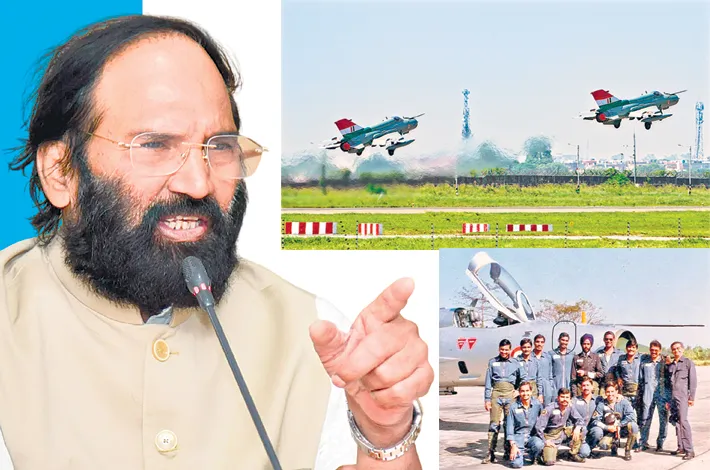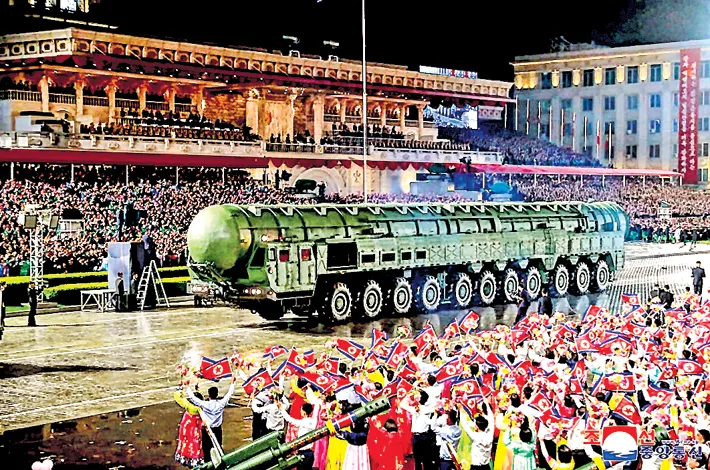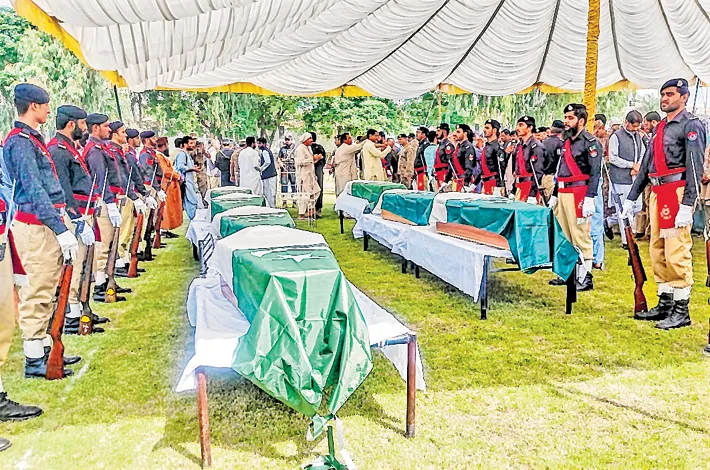Uttam’s Bond with MiG
30-09-2025 12:00:00 AM

planes were inducted into the Indian Air Force in 1963 and, since then, over 1,200 of the fighter jets have protected the country.
- May 3, 2002, MiG-21: Jalandhar. Crashed into building; 8 civilians killed, 17 injured, pilot ejected.
- January 5, 2021, MiG-21: Suratgarh. Crashed on sortie; pilot ejected, no ground damage.
- March 17, 2021, MiG-21: Gwalior. Crashed on takeoff; senior pilot killed.
- May 20, 2021, MiG-21: Moga. Night crash; pilot Sq Ldr Abhinav Choudhary died.
- August 25, 2021, MiG-21: Barmer. Village crash; pilot ejected, no other casualties.
- July 28, 2022, MiG-21: Barmer. Night crash; both pilots killed.
- October 12, 2022, MiG-29K: Off Goa. Navy jet crashed; pilot ejected, no ground casualties.
- May 8, 2023, MiG-21: Hanumangarh. Crashed into home; 3 civilians killed, pilot ejected.
- September 2024, MiG-29: Barmer. Night crash: undercarriage failure; pilot ejected.
- November 4, 2024, MiG-29: Agra. System malfunction; pilot Wg Cdr Manish Mishra ejected.
- 7 May 2025, MiG-29: Ramban. Wreckage found; pilot status unknown, possible missile strike.
On Friday when the Mikoyan-Gurevich MiG-21 made its last flight, a generation of pilots saluted the sturdy jet and one among them who flew it during the Indo-China border, Telangana’s Irrigation and Civil Supplies Minister N Uttam Kumar Reddy recalled his bond with the MiG. He said, “I flew the MiG-21 in Tezpur in Assam on the Indo-China border and subsequently the MiG-23 in the western sector,” he said. “The MiG-21 was a challenging aircraft to master, but it gave generations of pilots like me the thrill of supersonic flying. I feel proud to have been part of its legacy and also a bit emotional as it bows out,” he said.
What is more! The minister was just 20 when he piloted the supersonic jet. His bond with the MiG family, involved in high-stakes missions, depicts the aircraft’s storied history—a saga of Soviet innovation, global combat success, and India’s aerial dominance. From the MiG-15’s Cold War dominance to the MiG-21’s pivotal role in Indian victories, these jets have left a strong mark on aviation and the pilots who flew them.
Minister Uttam Kumar Reddy joined the National Defence Academy at 16, passing out as Flight Lieutenant (16971 F(P)) in 1982. Stationed in Tezpur, Assam, he flew MiG-21s guarding the Indo-China frontier, mastering the jet’s demanding delta-wing dynamics. Later, in the western sector, he piloted MiG-23s against potential Pakistani threats. An injury during a border operation in the late 1980s ended his flying career by 1992, after a decade of service. Even years later, his passion for the IAF endured. In 2016, amid Indo-Pak tensions, Reddy offered to rejoin reserves, stating that there was no greater honor than fighting for one’s country.
MiG’s legacy
The MiG legacy began in 1939 with the Soviet Mikoyan-Gurevich design bureau, founded by Artem Mikoyan and Mikhail Gurevich. Tasked with countering Western airpower, the bureau prioritized speed, simplicity, and mass production. The MiG-15, unveiled in 1949, was their first masterpiece. Powered by a Klimov RD-45 engine—a reverse-engineered Rolls-Royce Nene—it reached 668 mph (1,075 km/h) with swept wings optimized for transonic flight.
Its debut in the Korean War (1950–1953) was electrifying. In “MiG Alley,” MiG-15s clashed with U.S. F-86 Sabres, downing approximately 1,000 enemy aircraft while suffering similar losses, achieving a 1:1 kill ratio that shocked Western forces. Over 13,000 units were built, serving over 40 air forces, making it the most prolific jet of its era. Its success lay in its agility, low cost, and ability to operate from austere airfields, setting the stage for future MiGs.
Indian journey
The MiG’s journey in India began in 1963, when the IAF inducted the MiG-21, NATO’s “Fishbed,” amid escalating tensions with China following the 1962 war. Designed by the Soviet Mikoyan-Gurevich bureau, founded in 1939 by Artem Mikoyan and Mikhail Gurevich, the MiG-21 was a delta-wing interceptor capable of Mach 2 (1,385 mph) with a Tumansky R-11 engine delivering 13,230 lbf of thrust. Its nose-mounted radar enabled beyond-visual-range (BVR) intercepts, and its armament evolved from 23mm cannons to AA-2 Atoll missiles, making it a versatile fighter. India’s decision to acquire MiG-21s marked a pivot toward Soviet military hardware, driven by cost-effectiveness and geopolitical alignment during the Cold War. Over 11,000 MiG-21s were produced globally, the most-built supersonic jet, with India eventually operating over 800 across variants.
MiG’s trial by fire
The MiG-21’s trial by fire came during the 1965 Indo-Pak War. Deployed in limited numbers, it showcased its prowess, claiming 35 enemy aircraft—mostly Pakistani Sabres—with minimal losses, achieving a remarkable 10:1 kill ratio. Its climb rate of 225 mph/min and agility in dogfights overwhelmed opponents. The 1971 War cemented its legend. MiG-21s downed 45 Pakistani aircraft, including Sabres and Mirages, with a 4:1 kill ratio, playing a pivotal role in air superiority during Bangladesh’s liberation. Notable feats included the IAF’s first supersonic kill and precision strikes on Pakistani airfields, crippling their air force.
The MiG-23, introduced to India in 1979, further strengthened the IAF. With variable-sweep wings for Mach 2.35 (1,553 mph) and an S-23 radar for low-level strikes, it was ideal for both air combat and ground attack. Reddy flew these jets in the western sector, where their versatility shone. During the 1999 Kargil War, MiG-23s conducted precision strikes on Pakistani positions, achieving a 3:1 kill ratio in air engagements. Their ability to operate from high-altitude bases like Leh made them invaluable.
The MiG-23 which Minister Uttam also flew, introduced variable-sweep wings, enabling Mach 2.35 (1,553 mph) and low-level strike capabilities with its S-23 radar. In Indian service from 1979, it bolstered western defenses, achieving a 3:1 kill ratio during the 1999 Kargil conflict. For Reddy, flying the MiG-23 near Pakistan’s border was a masterclass in precision and nerve, as its complex systems demanded split-second decisions.
Legacy and Influence
By 2025, the IAF’s MiG-21s, once numbering over 800, were replaced by modern jets like the Rafale and Tejas. The retirement ceremony at Suratgarh, Rajasthan, marked the end of an era, with Uttam and other veterans reflecting on the jet’s unmatched legacy. India’s MiG journey—spanning the MiG-21, MiG-23, MiG-27, and MiG-29—saw over 1,200 aircraft serve, with the MiG-21 alone logging millions of flight hours. Their combat record—hundreds of kills, critical roles in 1965, 1971, and 1999—remains unmatched.
The MiG family’s success metrics are staggering: 13,000 MiG-15s, 10,000 MiG-17s, 3,000 MiG-19s, and 11,000 MiG-21s, serving dozens of nations. Their combat records—1:1 in Korea, 2:1 in Vietnam, 10:1 in 1965—reflect engineering brilliance and pilot skill. Yet, their legacy transcends numbers. For pilots like Reddy, the MiG-21 was a rite of passage, its cockpit a blend of terror and exhilaration. Group Captain Ajay Malik (Retd.) echoed Minister Uttam’s sentiments: “Bidding farewell is emotional; nothing better than this aircraft.” As India transitions to Rafales and Tejas, the MiG’s roar fades, but its spirit endures in the memories of pilots like Uttam Kumar Reddy. From Soviet drawing boards to Indian skies, MiGs shaped air warfare and the men who flew them, leaving a legacy of courage, innovation, and unbreakable bonds.








